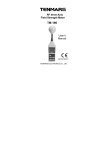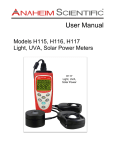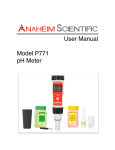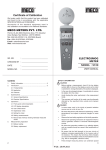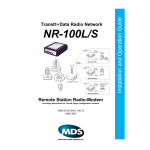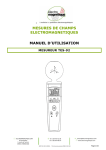Download Anaheim Scientific E201 Wide Range RF Field Strength Meter
Transcript
Model E201 Wide Range RF Field Strength Meter 2 Table of Contents 1 E201 METER QUICK START GUIDE .............................................. 4 2 INTRODUCTION ............................................................................... 5 2.1 The E201 Features: ................................................................... 5 2.2 E201 Applications: ..................................................................... 6 3 SAFETY SUMMARY ......................................................................... 7 4 EMF SAFETY .................................................................................... 8 5 COMPLIANCE STATEMENTS ......................................................... 9 6 PRODUCT CONTENTS AND INSPECTION .................................... 9 7 DEVICE DESCRIPTION ................................................................. 11 8 LCD DESCRIPTION ....................................................................... 12 9 10 FUNDAMENTALS .......................................................................... 13 9.1 Electromagnetic Pollution ......................................................... 13 9.2 Electric Field Strength (E) ........................................................ 13 9.3 Magnetic Field Strength (H) ..................................................... 13 9.4 Power Density (S) .................................................................... 14 9.5 The Characteristic of Electromagnetic Fields ........................... 14 DEVICE OPERATION ..................................................................... 15 10.1 Battery replacement ................................................................ 15 10.2 Power Key: .............................................................................. 15 10.3 Data Hold Key: ........................................................................ 16 10.4 Units Key: 16 10.5 MAX / AVG Record: ................................................................. 17 10.6 Manual Data Memory Storing .................................................. 17 10.7 XYZ/CALL: ............................................................................... 18 10.8 Alarm ON/OFF Setup .............................................................. 18 10.9 Viewing Data Records ............................................................. 19 10.10 Cancel Automatic Power-Off: .................................................. 19 anaheimscientific.com Technical data subject to change without notice ©Anaheim Scientific 2013. 20130805 3 10.11 11 12 13 Clock LCD Display ................................................................... 20 SETUP MODE ................................................................................. 20 11.1 Clock Setup-1 .......................................................................... 21 11.2 Setting the Alarm Limit Value (ALARM)-2 ............................... 22 11.3 DEL Data Logger Memory Setup-3 ......................................... 23 11.4 Analog Bar Graph Setup-4 ...................................................... 24 11.5 Auto Power-Off Function Setup-5 ............................................ 25 11.6 Setting the Calibration Factor (CAL)-6 .................................... 26 11.7 Calibration Factor (CAL): ......................................................... 27 MAKING MEASUREMENTS ........................................................... 28 12.1 Short-term Measurements: ...................................................... 28 12.2 Long-term Exposure Measurements ....................................... 29 SPECIFICATIONS ........................................................................... 30 13.1 General Specifications ............................................................. 30 13.2 Electrical Specifications ........................................................... 31 13.3 Units of Measurement ............................................................. 32 13.4 Result modes ........................................................................... 32 13.5 External DC Power .................................................................. 33 14 SERVICE, REPAIRS, CALIBRATION............................................. 34 15 LIMITED TWO-YEAR WARRANTY ................................................ 36 anaheimscientific.com Technical data subject to change without notice ©Anaheim Scientific 2013. 20130805 4 1 E201 Meter Quick Start Guide This meter has many capabilities, including memory, alarm, date/time, average etc. which will require some study of the manual to use properly. However, you can quickly and easily begin making measurements right out of the box. Just follow these simple steps: • Insert 9V battery • Press the “ ” button to turn on the meter. • Press XYX/MEM button until all three (XYZ) letters are displayed on the screen (to the left of the main number) • Press UNIT/ENTER “ ” button until the desired units are displayed below the main number (we recommend using mV/m… and we recommend a maximum level of 614 mV/m for prolonged exposure). You are now ready to make your first measurements! anaheimscientific.com Technical data subject to change without notice ©Anaheim Scientific 2013. 20130805 5 2 Introduction Thank you for purchasing the E201 Wide Range RF Field Strength Meter from Anaheim Scientific. This meter is designed for measuring and monitoring Radio– Frequency electromagnetic field strength. Compact, durable and easy to use. 2.1 The E201 Features: • The meter is a broadband device for monitoring high-frequency radiation in the range from 10MHz to 8GHz. • The non-directional electric field antenna and high sensitivity also allow measurements of electric field strength in TEM cells and absorber rooms. • Reports electrical and magnetic field strength and power density. At high frequencies, the power density is of particular significance. It provides a measure of the power absorbed by a person exposed to the field. This power level must be kept as low as possible at high frequencies. • The meter can be set to display the instantaneous value, the maximum value measured or the average value. Instantaneous and maximum value measurements are useful for orientation, e.g. when first entering an exposed area. • For (non-directional) isotropic measurements of electromagnetic fields with three-channel measurement sensor. • High dynamic range due to three-channel digital results processing. anaheimscientific.com Technical data subject to change without notice ©Anaheim Scientific 2013. 20130805 6 • • • • • Configurable alarm threshold and memory function. Easy & safe to use. Low battery indicator “ ”. Manual data memory storing: 200 data sets. Memory over load indication “OL”. 2.2 E201 Applications: • High frequency (RF) electromagnetic wave field strength measurement • Mobile phone base station antenna radiation power density measurement • Wireless communication applications (CW, TDMA, GSM, DECT) • RF power measurement for transmitters • Wireless LAN (Wi-Fi) detection, installation • Spy camera, wireless bug finder • Cellular /Cordless phone radiation safety level • Microwave oven leakage detection • Personal living environment EMF safety anaheimscientific.com Technical data subject to change without notice ©Anaheim Scientific 2013. 20130805 7 3 Safety Summary CAUTION Adhere to the following conditions for safe and effective usage of this meter • Do not operate the meter in an environment filled with combustible gas, liquids, dust or fibers • In order to avoid reading incorrect data, please replace the battery immediately when the symbol “ " appears on the LCD • In order to avoid damage caused by contamination or static electricity, do not touch the circuit board before taking adequate precautions • Operating Environment: This instrument has been designed for usage within an environment of Pollution Degree 2 • Operation Altitude: Up to 2000M • Operating temperature range: 0°C to + 50°C • Operating humidity range: 25% to 75 % RH • Storage temperature range: -10°C to +60°C • Storage humidity range: 0% to 80% RH • In the case of prolonged storage, it is preferable to remove the battery from the meter. • Avoid shaking the meter, particularly while in operation. • For cleaning the instrument use a soft dry cloth. Never use a wet cloth, solvents or water, etc. • Weather conditions outside the specified limits and improper handling may adversely affect the accuracy and function of the meter. anaheimscientific.com Technical data subject to change without notice ©Anaheim Scientific 2013. 20130805 8 4 EMF Safety • In some cases, work in the vicinity of powerful radiation sources can be life threatening. • Be aware that persons with electronic implants (e.g. cardiac pacemakers) are subject to particular dangers in some cases. • Observe the local safety regulations of the facility. • Observe the operating instructions for equipment which is used to generate, conduct, or consume electromagnetic energy. • Be aware that secondary radiators (e.g. reflective objects such as a metallic fence) can cause a local amplification of the field. • Be aware that the field strength in the near vicinity of radiators increases proportionally to the inverse cube of the distance. This means that enormous field strengths can result in the immediate vicinity of small radiation sources (e.g. leak in wave guides, inductive ovens) • Field strength measuring devices can underrate pulsed signals. Particularly with radar signals, significant measurement errors can arise. • All field strength measuring devices have a limited specified frequency range. Fields with spectral components outside of this frequency range are generally incorrectly evaluated and tend to be underrated. Before using field strength measuring devices, you should thus be certain that all field components to be measured lie in the specified frequency range of the measuring device. anaheimscientific.com Technical data subject to change without notice ©Anaheim Scientific 2013. 20130805 9 5 Compliance Statements Caution: This symbol indicates that the equipment and its accessories are subject to special collection and disposal procedures • This tester was designed in accordance with EMC Standards in force and its compatibility has been tested in accordance with EN61326-1 (2006). • Complies with: IEC 61000-4-2(2008, IEC 61000-4-3(2006) + (2007). 6 Product Contents and Inspection This unit is tested prior to shipment. It is therefore ready for immediate use upon receipt. An initial physical inspection should be made to ensure that no damage has been sustained during shipment. Inspect the packing box on receipt for any external damage. If any external damage is evident, remove the instrument and visually inspect its case and parts for any damage. If damage to the instrument is evident, a description of the damage should be noted on the carrier’s receipt and signed by the driver or carrier agent. Save all shipping packaging for inspection. anaheimscientific.com Technical data subject to change without notice ©Anaheim Scientific 2013. 20130805 10 Forward a report of any damage to the agent through which the unit is procured. Retain the original packing in case subsequent repackaging for return is required. Use of the original packing is essential. After the mechanical inspection, verify the contents of the shipment. The items included in this package are: • • • • • E201 Meter User manual 9V battery Carrying case AC to DC Adapter anaheimscientific.com Technical data subject to change without notice ©Anaheim Scientific 2013. 20130805 11 7 1. 2. 3. 4. 5. 6. 7. 8. 9. 10. 11. Device Description 3-Axis RF Sensor LCD Hold /ALARM / Up Button MAX / AVG/ Right Button UNIT / ENTER Button XYZ / MEM / Down Button Power Button REC/ Time / Leftward Button SET Button Tripod Mounting screw Battery Cover anaheimscientific.com Technical data subject to change without notice ©Anaheim Scientific 2013. 20130805 12 8 1. 2. 3. 4. 5. 6. 7. 8. 9. 10. 11. 12. 13. 14. LCD Description Primary Display Hold symbol Analogue bar graph MAX symbol AVG symbol Low battery symbol x1x10x100 unit X.Y.Z unit ALARM sound mV/m, V/m (E) µA/m , A/m unit (H) 2 2 µW/m / µW/cm unit E Symbol Auto power off symbol anaheimscientific.com 15. 16. 17. 18. 19. 20. 21. 22. 23. Time unit (month: day) (hour: minute) (second) MEM reading symbol SET symbol REC symbol CAL symbol Secondary Display 24. BUZZER symbol 25. Decimal point Technical data subject to change without notice ©Anaheim Scientific 2013. 20130805 13 9 Fundamentals 9.1 Electromagnetic Pollution This meter is used to indicate electromagnetic pollution generated artificially. Wherever there is a voltage or a current, electric (E) and magnetic (H) fields arise. All types of radio broadcasting and TV transmitters produce electromagnetic fields, and they also arise in industry, business and the home, where they affect us even if our sense organs perceive nothing. 9.2 Electric Field Strength (E) A field vector quantity that represents the force (F) on an infinitesimal positive test charge (q) at a point divided by that charge. Electric field strength is expressed in units of volts per meter (mV/m). This meter measures electric field strength directly. 9.3 Magnetic Field Strength (H) A field vector that is equal to the magnetic flux density divided by the permeability of the medium. Magnetic field strength is expressed in units of amperes per meter (A/m). In far field situations, one can calculate the magnetic field using the electric field value. This meter can display the calculated magnetic field strength. anaheimscientific.com Technical data subject to change without notice ©Anaheim Scientific 2013. 20130805 14 9.4 Power Density (S) Power per unit area normal to the direction of propagation, usually expressed in units of Watts per 2 square meter (W/m ) or, for convenience, units such as 2 milliwatts per square centimeter (mW/cm ). 9.5 The Characteristic of Electromagnetic Fields Electromagnetic fields propagate as waves and travel at the speed of light (C). The wavelength is proportional to the frequency. λ (wavelength) = C (speed of light) / f (frequency) If the distance to the field source is less than three wavelengths, then we are usually in the near-field. If the distance is more than three wavelengths, then far-field conditions usually hold. In near-field conditions, the magnetic field value cannot be calculated from the electric field value. This meter is designed for reliable far-field measurements only. anaheimscientific.com Technical data subject to change without notice ©Anaheim Scientific 2013. 20130805 15 10 Device Operation 10.1 Battery replacement WARNING If the symbol “ ” appears on the LCD, please replace the battery immediately • • • • • Turn off the instrument. Remove the battery cover. Replace the battery. Install the battery cover. Be sure to turn unit off after use to conserve battery life. 10.2 Power Key: Press “ ” key to turn ON the meter. Press “ ” key again to turn power OFF. anaheimscientific.com Technical data subject to change without notice ©Anaheim Scientific 2013. 20130805 16 10.3 Data Hold Key: Press the “ ” key to go into hold mode, and “HOLD” appears on the screen to allow you to read the data. Press “ ” key once again to deactivate it. >> > >> > 10.4 Units Key: Change units with the “UNITS” key as follows: • Electric field strength (V/m) • Computed magnetic field strength (mA/m) • Computed power density (mW/m2 ) 2 • Computed power density (µW/cm ) Press “ ” key to change the units: mV/m, V/m, µA/m, 2 2 2 mA/m, µW/m , mW/m , µW/cm . anaheimscientific.com Technical data subject to change without notice ©Anaheim Scientific 2013. 20130805 17 10.5 MAX / AVG Record: Press “ ” key to switch to the next display. The display switches from MAX to AVG to MAX/AVG and back to MAX. Press and hold “ ” key for 3 seconds to disable this function. The maximum storage is up to 99 minutes and 99 seconds. After this period of time, updating will be stop automatically and then the LCD displays . 10.6 Manual Data Memory Storing Press “ ” key, the meter will save the current measured result, and REC with a number 001~200 will appear. Manual data memory storing: 200 data sets. Over load Indication: “OL”. anaheimscientific.com Technical data subject to change without notice ©Anaheim Scientific 2013. 20130805 18 10.7 XYZ/CALL: Press “ ” key to change sensor axis selector: “All axis” » “X axis” » ”Y axis” » “Z axis”. 10.8 Alarm ON/OFF Setup Press and hold “ ” the press “ ” key to switch the alarm function on. The “ALARM” symbol in the display indicates that the alarm function is on. Press and hold “ ” and“ ” keys to turn off the alarm function. When the Alarm sounds, the display shows anaheimscientific.com . Technical data subject to change without notice ©Anaheim Scientific 2013. 20130805 19 10.9 Viewing Data Records Press and hold the “ ” key and press the “ to view the saved data records. Use “ ” key ” or “ ” key to see the next or previous records. Press the “ ” key to close and exit this mode. 10.10 Cancel Automatic Power-Off: The default setting is auto power-off and the time is set for 15 minutes. Press and hold the “ “ ” key and press ” key to disable the automatic power-off. The symbol of will disappear on the LCD display. Press and hold the “ ” key and press the “ ” key again to enable the automatic power-on. The symbol of will appear on the LCD display. anaheimscientific.com Technical data subject to change without notice ©Anaheim Scientific 2013. 20130805 20 10.11 Clock LCD Display Press and hold the “ ” and “ ” keys to select the display method of the Year, Month, Date, hour and Second. This meter’s clock uses 24 hour time setting. Default time mode setting is “2010/01/07 00: 02” “:00”. 11 Setup Mode Press and hold “ ” key first and then “ ” button to enter the Setup Mode. Press “ ” key to change setup functions. Push “ ” key to save setup data You can set up 6 different functions in setup mode: • Setup 1: Clock Setup-1 • Setup 2: Setting the Alarm Limit Value (ALARM)-2 anaheimscientific.com Technical data subject to change without notice ©Anaheim Scientific 2013. 20130805 21 • • • • Setup 3: Clear Data Logger Memory-3 Setup 4: Analogue Bar Graph Setup-4 Setup 5: Auto Power-Off Time Function Setup-5 Setup 6: Setting the Calibration Factor (CAL)-6 11.1 Clock Setup-1 Press and hold the “ ” key first and then the “ ” key to enter the Setup Mode. Press “ ”or “ ” key to select the setting to adjust. Press “ ”or “ ” key to change the date and time (hour→day→month→year→minute). Press “ ” key to save and exit. This meter clock is 24 hour time setting. Date/Time default Format : 2009/12/21 12:12. Year Format : 2000~2099 display as 00 ~ 99. anaheimscientific.com Technical data subject to change without notice ©Anaheim Scientific 2013. 20130805 22 11.2 Setting the Alarm Limit Value (ALARM)-2 The alarm limit value determines the level at which the alarm will sound. The alarm limit value can be edited in only in the V/m unit. The ALARM setting range is from 0.001 to 999.9V/m. ALARM default is set at 999.9V/m. Alarm limit function is only used for total three axial value. Press hold “ ” key first and “ ” key to enter the Setup Mode. Press “ ” key again to enter the alarm setting mode. Press “ ” key to move decimal. Press “ ” key to select the desired setting value. Press “ ” key and “ anaheimscientific.com ” key to change digit. Technical data subject to change without notice ©Anaheim Scientific 2013. 20130805 23 Press “ ” key to select the value. Press “ ” key to store the new setting value and exit. 11.3 DEL Data Logger Memory Setup-3 Press and hold “ ” key first and then “ enter the Setup Mode. Press “ ” key to ” key twice to enter the default display ’ ’’. Press “ ” or “ ” key to select . anaheimscientific.com Technical data subject to change without notice ©Anaheim Scientific 2013. 20130805 24 Press “ ” key to delete the memory and exit. Press “ ” or “ press “ ” to keep the memory and exit. ” key to select ’ ’’ and then 11.4 Analog Bar Graph Setup-4 Press and hold the “ ” key first and then the“ ” key to enter the Setup Mode. Press “ ” key three times to enter the analog bar graph setting mode. The ”graph” unit is flashing displaying X1, X10, X100. Press “ ” or “ ” key to select the value X1,X10, X100 anaheimscientific.com Technical data subject to change without notice ©Anaheim Scientific 2013. 20130805 25 Press “ ” key to save and exit 11.5 Auto Power-Off Function Setup-5 Press and hold the “ ” key first and then “ ” key to enter the Setup Mode. Press “ ” key four times. The symbol is displayed. The auto power-off time default setting is 15 minutes. Press “ “ and “ ” keys to change to: 00~99 minutes. Press “ ” key to save and exit. : 00 Auto power-off disable. : 99 Maximum auto power-off time anaheimscientific.com Technical data subject to change without notice ©Anaheim Scientific 2013. 20130805 26 11.6 Setting the Calibration Factor (CAL)-6 Press “ ” key first and then “ ” key to enter the Setup Mode. Press “ ” key five times to display the “CAL SET ” the default factor. Default is 1.00 which is appropriate for most situations. The CAL setting range is from 0.10 to 9.99. ~ Press “ “ or “ “ key to select the value. Press “ ” or “ ” key to select the digits. Press “ ” key to save and exit. Please refer to the following calibration factors of our standard meter verified by the laboratory : anaheimscientific.com Technical data subject to change without notice ©Anaheim Scientific 2013. 20130805 27 (MHz) (V/m) (V/m) X Y Z Average Factor (dB) 1800 1.00 0.77 0.68 0.85 0.77 1.1 2450 1.00 0.94 0.92 0.96 0.94 1.1 11.7 Calibration Factor (CAL): The calibration factor CAL serves to calibrate the result display. The field strength value measured internally is multiplied by the value of CAL that has been entered and the resulting value is displayed. The CAL setting range is from 0.10 to 9.99. The CAL factor is often used as a means of entering the sensitivity of the field sensor in terms of its frequency response in order to improve measurement accuracy. The following effect will be noted with all field strength meters : • If the sensor is moved quickly, excessive field strength values could be displayed. This effect is caused by electrostatic charges. • Recommendation: hold the meter steady during the measurement. anaheimscientific.com Technical data subject to change without notice ©Anaheim Scientific 2013. 20130805 28 12 Making Measurements Important: The following effect will be noted with all field strength meters. If the sensor is moved quickly, excessive field strength values could be displayed. This effect is caused by electrostatic charges. Recommendation: Hold the meter steady during the measurement. 12.1 Short-term Measurements: Application: Use either the “instantaneous” or the “Max .instantaneous” mode if the characteristics and orientation of the field are unknown when entering an area exposed to electromagnetic radiation. Procedure: Hold the meter at arm’s length. Make several measurements at various locations around your work place or the interested areas as described above. This is particularly important is the field conditions are unknown. Pay special attention to measuring the vicinity of possible radiation sources. Apart from active sources, those components connected to a source may also act as radiators. For example, the cables used in diathermy equipment may also radiate electromagnetic energy. Note that metallic objects within the field may locally concentrate or amplify the field from a distant source. anaheimscientific.com Technical data subject to change without notice ©Anaheim Scientific 2013. 20130805 29 12.2 Long-term Exposure Measurements Location: Place the meter between yourself and the suspected source of radiation. Make measurements at those points where parts of your body are nearest to the source of radiation. Note: Use the “Average” or” Max average” modes only when the instantaneous measurement values are fluctuating greatly. You may fix the meter to a wooden or plastic tripod anaheimscientific.com Technical data subject to change without notice ©Anaheim Scientific 2013. 20130805 30 13 Specifications 13.1 General Specifications Display Type Liquid-crystal (LCD), 4-1/2 digits, maximum reading 19999 Measurement Digital, triaxial measurement Method Directional Type Isotropic (triaxial) Range Selection One continuous range Resolution 0.1mV/m, 0.01V/m, 0.1µA/m, 0.1mA/m, 2 2 0.001µW/m , 0.01mW/ m , 0.001µW/cm 2 Setting Time Typically 1.5s (0 to 90% measurement value) Sample Rate 1.5 times per second Units mV/m, V/m, µA/m, mA/m, µW/m , mW/m , µW/cm Display Value Instantaneous measured value, maximum value, 2 2 2 average value, or maximum average value Audible Alarm Buzzer Alarm Function Adjustable threshold with ON / OFF Calibration Adjustable Factor Data 200 Data Sets Storage/Recall Batteries 9V Battery Life Approximately 3 hours Auto Power-Off Default time 15 minutes. Adjustable threshold 0~99 minutes Dimensions 370(L) x 80(W) x 80(H) mm Weight Approx. 400g (including battery) anaheimscientific.com Technical data subject to change without notice ©Anaheim Scientific 2013. 20130805 31 13.2 Electrical Specifications Unless otherwise stated, the following specifications hold for the following conditions: • • • • The meter is located in the far field of a source Sensor head is pointed towards the source Ambient Temperature: +23 °C, ±3°C Relative Humidity: 25%~75% Sensor Type Frequency Range Specified Measurement Range Electrical Field (E) 10MHz ~ 8 GHz • CW signal (f >50MHz): 38 mV/m to 11.00 V/m 53.0 µA/m to 28.64 mA/m 2 2 0.1 µA/m to 309.3 mW/m 2 2 0µ W/cm to 30.93 mW/cm Dynamic range • Typically 75dB Absolute error at 1V/m and 2.45GHz Frequency Response • ± 1.0 dB Isotropy deviation • Typically ±1.0dB (2.45GHz) Overload limit • 0.083mW/cm , (17.7 V/m) per axis Overload limit • (0 to 50°C): ±0.2dB anaheimscientific.com • Sensor taking into account the typical CAL factor: ±2.4dB(50 MHz to 1.9 GHz, 3.5 GHz to 8GHz) ±1.0dB (1.9 GHz to 3.5GHz) 2 Technical data subject to change without notice ©Anaheim Scientific 2013. 20130805 32 13.3 Units of Measurement The meter measures the electrical component of the field; the default units are those of electrical field strength (mV/m or V/m). The meter converts the measurement values to the other units of measurement, i.e. the corresponding magnetic field strength units 2 (µA/m or mA/m) and power density units (µW/m , 2 2 mW/m or µW/cm ) using the standard far-field formula for electromagnetic radiation. 13.4 Result modes The bar graph display always shows the instantaneous measured dynamic range value. The digital display shows the result according to one of three modes, which can be selected. Instantaneous: The display shows the last value measured value measured by the sensor, no symbol is displayed. Maximum instantaneous (MAX): The digital display shows the highest instantaneous value measured, the “MAX “symbol is displayed. anaheimscientific.com Technical data subject to change without notice ©Anaheim Scientific 2013. 20130805 33 Average (AVG): The digital display shows the average value measured, the “AVG” symbol is displayed. The following graph shows Instantaneous (actual), MAX (hold), AVG and MAX/AVG: 13.5 External DC Power External AC to DC adapter: Voltage: 9V DC (8~14VDC Max) Output current: 500mA Socket: Center Pin Positive Outer Diameter 5.5mm; Internal Diameter 2.1 mm anaheimscientific.com Technical data subject to change without notice ©Anaheim Scientific 2013. 20130805 34 14 Service, Repairs, Calibration • The following are instructions regarding policies for servicing, repairing or calibrating Anaheim Scientific products. Turnaround time is usually less than ten (10) working days unless expedited service is requested and pre-arranged. • Send an email to [email protected] requesting an RMA number specifying your request for either service/repair and/or calibration with your product’s model number. • Once you receive a reply from [email protected], you will be asked to ship prepaid to the address below. Package the unit carefully using filler or bubble wrap, and if possible, ship in the original box. Ship each unit separately. (Anaheim Scientific is not responsible for any shipping damage that may occur.) • Include a packing list with each unit shipped stating what type of service is required and include the return shipping information: name, address and telephone number. • If the unit is in warranty, please provide the following: proof of purchase or copy of the original invoice. • If the unit is out of warranty, prepayment is required by Check, Money Order or Credit Card. • Return all merchandise to Anaheim Scientific with pre-paid shipping. The flat-rate repair charge for Non-Warranty Service does not include return shipping. Return shipping to locations in North American is included for Warranty Service. anaheimscientific.com Technical data subject to change without notice ©Anaheim Scientific 2013. 20130805 35 • For overnight shipments and non-North American shipping fees please contact Anaheim Scientific Anaheim Scientific ATTN: Service/Repair 22820 Savi Ranch Parkway Yorba Linda, CA 92887 www.anaheimscientific.com anaheimscientific.com Technical data subject to change without notice ©Anaheim Scientific 2013. 20130805 36 15 Limited Two-Year Warranty • Scientific warrants to the original purchaser that its products and the component parts thereof, will be free from defects in workmanship and materials for a period of two years from date of purchase. • Anaheim Scientific will, without charge, repair or replace, at its option, defective product or component parts. Returned product must be accompanied by proof of the purchase date in the form of a sales receipt. • To help us better serve you, please complete the warranty registration for your new instrument via our website www.anaheimscientific.com • Exclusions: This warranty does not apply in the event of misuse or abuse of the product or as a result of unauthorized alterations or repairs. The warranty is void if the serial number is altered, defaced or removed. • Anaheim Scientific shall not be liable for any consequential damages, including without limitation damages resulting from loss of use. Some states do not allow limitations of incidental or consequential damages. So the above limitation or exclusion may not apply to you. • This warranty gives you specific rights and you may have other rights, which vary from state-to-state. anaheimscientific.com Technical data subject to change without notice ©Anaheim Scientific 2013. 20130805 37 anaheimscientific.com Technical data subject to change without notice ©Anaheim Scientific 2013. 20130805 38 anaheimscientific.com Technical data subject to change without notice ©Anaheim Scientific 2013. 20130805 39 anaheimscientific.com Technical data subject to change without notice ©Anaheim Scientific 2013. 20130805 40 22820 Savi Ranch Parkway Yorba Linda, CA 92887 www.anaheimscientific.com © 2013 Anaheim Scientific anaheimscientific.com Technical data subject to change without notice ©Anaheim Scientific 2013. 20130805











































